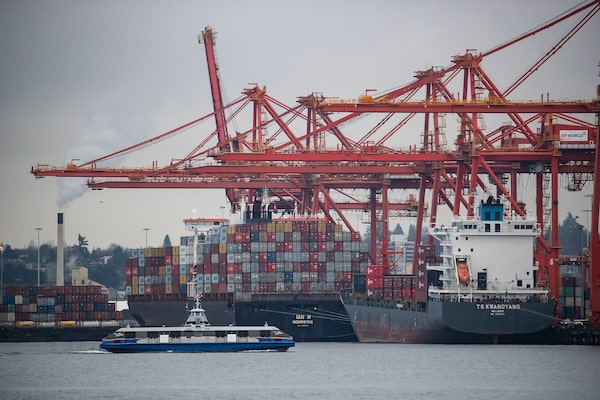
Gantry cranes tower above container ships being unloaded and loaded at the Port of Vancouver.DARRYL DYCK/The Canadian Press
Lawrence Herman is an international lawyer with Herman & Associates and a senior fellow at the C.D. Howe Institute in Toronto.
China’s disruptive behaviour had de-stabilized the global trading order well before Russia’s invasion of Ukraine last February. Such geopolitical trends, among others, have converged to produce tectonic shifts in international business as we go forward into 2023.
So, what does this mean for what still remains of the post-Second World War rules-based trading system?
For starters, the World Trade Organization, the body that oversees the multilateral system, is under considerable stress. In spite of exhortations at its ministerial meeting last June and a recent plea from its director-general, the WTO has floundered over the past few years.
The problems are deeply entrenched. The WTO is mired in internal governance difficulties, its negotiating activities have stalled and its once-heralded dispute settlement function is paralyzed because of serious disagreements over the appeal mechanism. As well, it’s largely been a bystander in dealing with the critical challenges of the COVID-19 pandemic and climate change, and few advances are likely this coming year in other key concerns such as trade in medicines, net-zero carbon policies, distortions of agricultural and other subsidies, communications technology, and digital trade.
This has led to like-minded countries agreeing to settle trade disputes through voluntary arbitration outside the WTO system. This is a good thing, but it’s also a reflection of its diminished standing as an authoritative global institution.
While the organization struggles, major regional trade agreements outside the WTO have emerged, covering vast geographic and economic spheres, including the Canada-U.S.-Mexico Agreement, the Trans-Pacific Partnership Agreement and the Regional Comprehensive Economic Partnership among Asian-Pacific countries. These regional treaties include progressive new rules on digital commerce, data transfers, and climate change and the environment – issues on which the WTO hasn’t even started to negotiate seriously. Such agreements will have a significant influence in shaping the global trading order in 2023, further diminishing the WTO’s paramountcy as a global rule-making and dispute-settlement body.
That’s not to say the picture is entirely bleak. Even with these headwinds, the WTO will continue to function in workmanlike ways, providing useful data and analyses of world trade flows and issuing reports on members’ actions in applying – or disregarding – its rules. But it’s difficult to foresee much forward progress in the WTO’s ability to deal with major global challenges in the coming year. Whether it has reached the limits of collective achievement or whether the deep-seated difficulties facing the multilateral trading system can be resolved remains to be seen. The picture for 2023 – and indeed beyond – is not encouraging.
Meanwhile, Russia’s invasion of Ukraine, China’s aggressiveness and actions of bad actors such as Iran have produced an intensified wave of trade and economic sanctions by the governments of Western allies, led by Washington. Unilateral sanctions will continue with increased force into 2023, further affecting banking, financial and other business transactions and forcing extensive supply chain reconfigurations.
The coming year will also see an expansion of export controls, another powerful economic weapon deployed by Western governments that extend beyond trade in nuclear, arms, munitions and military items to prevent exports of advanced digital technologies, such as microprocessors and other highly sensitive goods and services. These prohibitions have long-term strategic underpinnings, as opposed to economic sanctions that react to specific events. Moving forward, look for increased use of both sanctions and export controls by Western allies.
With governments often slow to react, particularly given the lack of progress at the multilateral level, non-binding private global regulation has also increasingly moved into the vacuum. Private-sector action will thus further develop as a major trade factor in 2023. We have seen this in the corporate pursuit of climate-related action and a net-zero carbon world through far-reaching, but non-mandatory, risk-assessment tools in the environmental, social and governance domain.
This trend is also visible in the decisions by many companies – often ahead of intergovernmental agreement or legal requirements – to stop doing business in Russia in solidarity with Ukraine, even if it means shutting down operations and writing off investments. These kind of private-sector rules, practices and standards – often called private global governance – will be an increasingly indelible feature of international business in the coming year.
In short, world trade in the next 12 months will be deeply affected by continued setbacks at the multilateral level, further proliferation of unilateral governmental trade measures, expanded trade regionalism, and increases in wide-ranging but non-legislated global business rules and standards. It will be interesting to assess the impact of these forces in a year’s time, as Western governments and international business adjust to these profound changes in the global trading order.